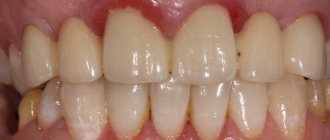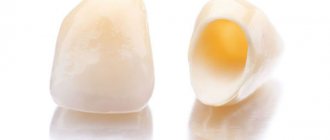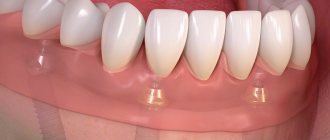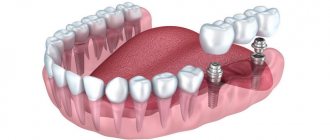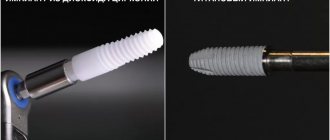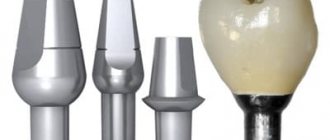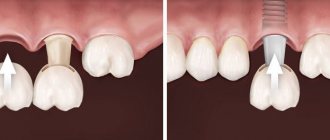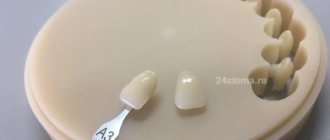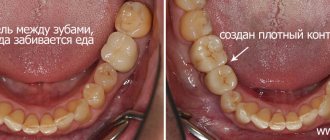If a tooth is severely damaged, there is a choice - to restore the problematic unit with a crown or remove it and install an implant. Both options are used to replenish the dentition. The crown restores only the upper part; the root must be healthy to avoid complications in the future. This type of prosthetics has optimal prices and few contraindications, but there is no guarantee that it will last long in case of poor-quality root canal treatment. An implant is a full-fledged copy of a lost tooth; a titanium root is implanted into the jaw, performs the functions of a real one, and is covered with a crown on top. Implantation is an expensive treatment option, but it comes with a lifetime guarantee.
What is the difference between a dental implant and a crown?
- An implant is an artificial metal root that is surgically installed into the jawbone. Made of non-toxic medical titanium, hypoallergenic, not rejected by the body. The crown is fixed on top - immediately after installing the implant or after it has fused with the bone tissue. The duration of prosthetics depends on the chosen implantation protocol - based on the results of an analysis of the condition of the bone tissue. The service life of the implants is lifelong; you only have to change the crown once every 15 years, and if properly cared for, the service life is the same.
- Crown - a prosthesis made of ceramic, zirconium or other material. This is the top of the dental unit, a kind of cap that is attached to the preserved part. Restores the aesthetic defect and functions of the coronal part. An important condition for this method of restoration is the absence of inflammation at the root. Constructions that rely on your own teeth last up to 10 years, and in case of inflammatory processes they have to be removed to re-treat the roots.
The fundamental difference between an implant and a crown is the installation method. To place an implant, it is necessary to remove the problematic unit of the dentition. The crown is installed on your own tooth, as it needs support, and only partially restores it; it is the upper outer shell. In addition, methods differ in service life, price and other parameters.
What is a crown
A crown is simply the shell of a tooth that is attached to the top of a damaged tooth. The crown can also be attached to neighboring teeth.
There are:
- Plastic crowns that are installed temporarily.
- Metal crowns.
- Gold crowns.
- Ceramic crowns.
- Metal-ceramic crowns.
Advantages of installed crowns:
- The cost is several times lower than that of implants.
- Short production time.
- Short installation time.
Disadvantages that encourage you not to install crowns:
- They are short-lived compared to implants.
- To install a crown, you need to grind down your teeth.
- There is a risk of damage to adjacent teeth.
In what cases do you need to install crowns:
- Complete destruction of the tooth shell.
- Severe destruction of the tooth crown due to dental diseases.
- Increased tooth wear.
Like implants, crowns have their own contraindications:
- Possibility of a negative reaction to anesthesia.
- Diseases of the jaw bones (for example, osteoporosis or osteomyelitis).
- Exhaustion of the body.
- Age restrictions: crowns cannot be placed on persons under 16 years of age.
- Neglect of oral hygiene.
- Malocclusion.
- A complete contraindication to surgery.
- Exacerbation of diseases of such systems as the nervous, immune, endocrine and cardiovascular.
- Periodontitis and its consequences.
Pros and cons of methods
Implantation
Advantages
- Lifetime service life and warranty in our Center
- No bone atrophy around the implant
- High chewing loads, no restrictions on food consumption
- High aesthetics
- Easy care
Flaws
- Requires surgical intervention, causes concern for patients
- Possible contraindications to surgery
- Rehabilitation from 2 to 6 months
- The cost is higher than restoration with crowns
- Possible rejection if recommendations are not followed
Installation of crowns
Advantages
- Non-traumatic installation
- Installed in 1-3 doses, if no prior treatment is required
- Virtually no contraindications
- Satisfactory aesthetics
- The cost is lower than when installing implants
Flaws
- Short service life - on average 7 years
- Do not load with too hard food
- If the condition of the root is unsatisfactory, its treatment is required - up to 1 month
- The likelihood of developing inflammatory processes under the crown
- If there is little tissue left, it is necessary to make a stump inlay, which increases the cost
Possible complications and contraindications
A complex prosthetic operation is not without possible complications:
- The stitches placed may come apart.
- Further difficulty in prosthetics, which is directly related to incorrect and non-functional installation of the implant.
- Infection in the implant area, subsequent inflammation, which quickly leads to rejection of the implanted element.
- If there is a lack of bone tissue, perforation of the maxillary sinus occurs.
- During the implantation operation, the nerve located below the jaw is affected and damaged.
- In case of poor blood clotting, heavy bleeding begins.
The listed complications can occur during the implantation procedure and after the operation.
Before installing implants, you need to familiarize yourself with a fairly large list of contraindications, which are divided into types.
Absolute contraindications
- Tumors, both malignant and benign. The operation to install implants will dramatically worsen the patient’s condition. Contraindications apply to any cancer.
- Any blood diseases. For example, poor clotting will certainly lead to quite serious consequences during the operation.
- Tuberculosis and any complications that arise after the illness.
- Diabetes mellitus of any type.
- Serious nervous disorders. This applies to both acquired and congenital diseases. A patient with this particular condition may behave inappropriately during surgery and during subsequent treatment.
- Any diseases of the oral mucosa.
- Increased tone of the masticatory muscles.
- Connective tissue diseases.
- Poor state of human immunity (may be caused by previous diseases). The patient’s body may simply not cope with the subsequent rehabilitation period. After the operation, increased work of all organs will be required. It will be necessary to fully recover.
Relative contraindications
- Caries and other diseases.
- Inadequate oral hygiene (in this case, removable dentures are recommended).
- Arthrosis.
- Periods of pregnancy and lactation.
- Periodontitis.
- Any defects of the jaw and bone tissue.
- Serious inflammation of the gums.
- Pathological bite.
- Having bad habits. These mainly include three: drug addiction, alcoholism and smoking.
Some types of contraindications overlap with each other depending on the group.
Temporary contraindications
- Period of acute illness.
- Pregnancy.
- Lactation.
- Addiction.
- Alcoholism.
- After irradiation (about a year later).
- The patient's stage of recovery after illness.
- The stage of rehabilitation after an illness.
General contraindications
- Poor oral hygiene.
- Diseases of the central nervous system and mental disorders.
- Immunotherapy and antidepressants, cytostatics, anticoagulants and some other medications used before the start of prosthetics, which seriously affect the recovery process after surgery and the further safety of the installed implants.
- Stress for a long time.
- Exhaustion of the body.
Local contraindications
- The patient does not try to take care of the oral cavity.
- The distance to the maxillary region does not correspond to the standard value.
- The quality and quantity of bone tissue does not meet the requirements for implantation of a foreign implant.
What to put on a dead tooth
A dead tooth is pulpless, without a nerve. A root without pulp becomes brittle and may not withstand heavy loads. If the root breaks, the prosthesis will need to be changed urgently. It will not be possible to preserve the old design; you will have to make a new one, and this will be an unforeseen expense. In the case of implantation, there are no such risks.
In addition, in case of severe damage, the dental unit must be strengthened and a pin installed in the root. But even with a positive prognosis, there is no guarantee that a crown with a pin will last at least 10 years. In case of critical damage, stump inlays are installed, which are made according to casts to order. The recovery process becomes longer and more expensive.
In difficult cases, there is no guarantee that the structure will last long. Therefore, it is necessary to assess the condition of the tooth and predict the duration of its functioning. If the prognosis is unfavorable, it is better not to spend money, remove the problematic molar or incisor, and install an implant that will last a lifetime.
If the cost of restoration with a crown with preliminary treatment is comparable to implantation, preference is given to the latter. You will receive a warranty from the manufacturer and from the clinic for the implant, and a 1-year warranty for treatment and prosthetics.
Prices for implantation in Moscow
| Name | Cost, rub. |
| “Astra Tech” implant system | |
| Implant with cement fixation system | 85000,00 |
| Implant with screw fixation system | 94000,00 |
| Implant with 2-component fixation system | 97000,00 |
| Alpha Bio Tec system implants | |
| Implant with cement fixation system | 65000,00 |
| Implant with screw fixation system | 74000,00 |
| Implant with 2-component fixation system | 78000,00 |
| Implants of the Dentmol system | |
| Implant with cement fixation system | 70000,00 |
| Implant with screw fixation system | 78500,00 |
| Implant with 2-component fixation system | 83000,00 |
| Implants of the MIS system | |
| Implant with cement fixation system | 66000,00 |
| Implant with screw fixation system | 74000,00 |
| Implant with 2-component fixation system | 78000,00 |
| Implants of the Nobel system | |
| Implant with cement fixation system | 85000,00 |
| Implant with screw fixation system | 94000,00 |
| Implant with 2-component fixation system | 97000,00 |
What is better to put on chewing and front teeth?
If the incisors or molars are well treated, only the crown part is destroyed, and the root is not affected by caries, there are no cracks or inflammations, crowns can be placed. But you need to choose the right materials.
Restoration of the anterior incisors must meet high aesthetic requirements. The best option is a single prosthesis made of metal-free ceramics (it has natural translucency, is as similar as possible to natural enamel, but does not withstand heavy chewing loads).
Chewing molars are subject to severe stress, so it is important that the restoration method is reliable. You should choose durable materials, the best is zirconium dioxide - it is not inferior in strength to metal ceramics, but is more aesthetically pleasing and durable.
If the dentist has doubts about the quality of treatment, it is better to perform an extraction and install implants. There are methods of immediate implantation immediately after removal into a fresh socket - this will shorten the treatment time, there is no need to wait for healing or restoration of bone tissue.
For anterior incisors, a prosthetic restoration can be placed immediately using an immediate loading protocol. It is better not to load chewing teeth immediately, but to carry out classical implantation with delayed loading, because implants can become dislodged when chewed.
Brief characteristics of dental crowns
A crown is a special structure that forms a covering on top of a tooth that has certain defects. It completely restores chewing functions and creates an aesthetic effect. Crowns are divided into several types depending on the material used.
Types of dental crowns:
- metal;
- ceramic;
- metal-ceramic;
- plastic;
- metal-plastic;
- zirconium.
The cost of the crown, its performance and durability depend on the type of material.
Sometimes the difference between implantation and crown installation is only a couple of thousand rubles
Sometimes the difference is only a couple of thousand rubles due to the need for preliminary treatment before installing an orthopedic structure. If the tooth is severely damaged, additional costs will be required - strengthening with a pin or inlay. The patient pays for depulpation and root canal treatment. In addition, caries often develops under the denture. Even with good treatment, the root with the removed nerve is vulnerable to infection and is fragile, it can break even under light load.
Levin Dmitry Valerievich
Chief physician, Ph.D.
Implants come with a lifetime warranty. The most that will need to be replaced is a prosthesis. As research has proven, the service life of orthopedic structures based on artificial rather than living roots increases by 30–40%. With daily careful hygiene, the service life coincides with the implants.
What to expect after implant placement
After implantation, the following are possible:
- swelling of the gums and cheeks;
- numbness of the gums;
- painful sensations after the anesthesia wears off.
All these symptoms disappear on the same day and the next day after surgery. A poorly performed operation or incorrect actions by the surgeon can lead to more serious consequences:
- injury to the maxillary sinuses;
- damage to the roots of adjacent teeth;
- infection.
Thus, the choice of clinic and doctor is very important.
What to choose - to summarize
| Implant | Crown | |
| Traumatic installation | high | short |
| Speed of tooth restoration | 2-6 months | from 2 days |
| Reliability of fixation | very high | above average |
| Need for replacement | No | Yes |
| Possibilities | any missing tooth | if there is no fracture and inflammation at the root |
| Life time | for life | 5-15 years |
| Price | high | depends on the need for pre-treatment |
Implants are reliable and durable. They imitate the structure of an incisor or molar. The lifetime service life of the titanium rod can be guaranteed. But surgical intervention is a necessary measure; no implant can replace a natural root. The dentist’s task is to preserve even part of the element of the dental system. A well-treated tooth and a correctly installed orthopedic structure create conditions for long service life and high aesthetics.
On the other hand, a root without pulp can no longer be called complete. Without nutrition, tissue breaks down, leading to organ loss. Then, in order to pay twice, it is better to install the implant immediately.
The doctor will tell you what is best to choose after diagnosis and examination.
Implant attachment
The implant and crown are secured using a material such as cement. It provides strong and 100% grip. In dental practice, there are situations when temporary crowns are initially installed on an implant. After some time, they are removed and permanent ones are attached.
The crown on the implant tends to wear out and become loose over time. In this case, it is not worth restoring it; it is better to resort to complete replacement.
The implant is installed with the mandatory use of anesthesia. It is done locally. Next, the prosthesis is slowly implanted into the gum and internal suturing is performed. After a long time (about 3-6 months), the implant grows into the jaw. Then the gum former is installed. Afterwards, an impression of the gum is made, on the basis of which a crown is made. It should be noted that dentures take root faster on the lower jaw than on the upper jaw.
Benefits of Dental Implants
Dental implantation is one of the most popular methods of dental restoration, successfully used in developed countries of the world. The procedure has a number of undeniable advantages.
Benefits of implantation:
- complete restoration of chewing functions;
- the process of implanting an artificial root does not have a negative impact on other teeth in the row;
- complete aesthetic transformation of a smile;
- does not cause discomfort to a person, completely takes root;
- can be used for complete and partial edentia;
- prevents gum deformation and tissue necrosis;
- strong and durable prosthesis, comparable in all respects to natural human teeth.
Among the disadvantages of implantation: the high cost of the procedure, the risk of rejection of the implant by the body, long-term rehabilitation after implantation and an extensive list of contraindications.
Crowns supported by a core inlay
The stump tab is a structure that is fixed inside the root. It creates a support for further prosthetics without removing the root. The design has several pins installed in the root canals and a stump part, which is necessary for fixing the crown. Installation of a stump tab is possible only if there are indications:
- The crown is damaged by more than 60%;
- The upper part has a fracture;
- After caries treatment, the tooth walls have a suitable thickness.
If the conditions and requirements were not met when installing the stump inlay, the patient may be injured, damage bone tissue, adjacent teeth, and the root will need to be removed.
Contraindications:
- Inflammation of the gums near the root;
- Cyst, granuloma;
- Thin walls of the tooth;
- Short channels for installing pins;
- Allergy to materials.
Stump inlays are made from metal alloys, metal-ceramics, ceramics, and zirconium. Crowns for them are selected accordingly - from metal, metal-ceramics, solid ceramics, zirconium. If you have an allergy to metal, the design is selected entirely from hypoallergenic materials - ceramics or zirconium.
